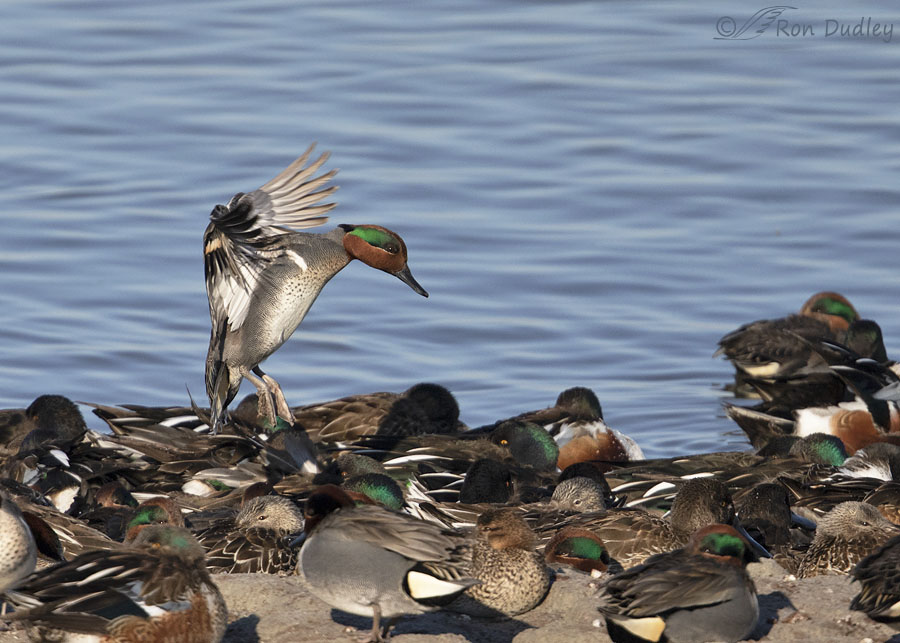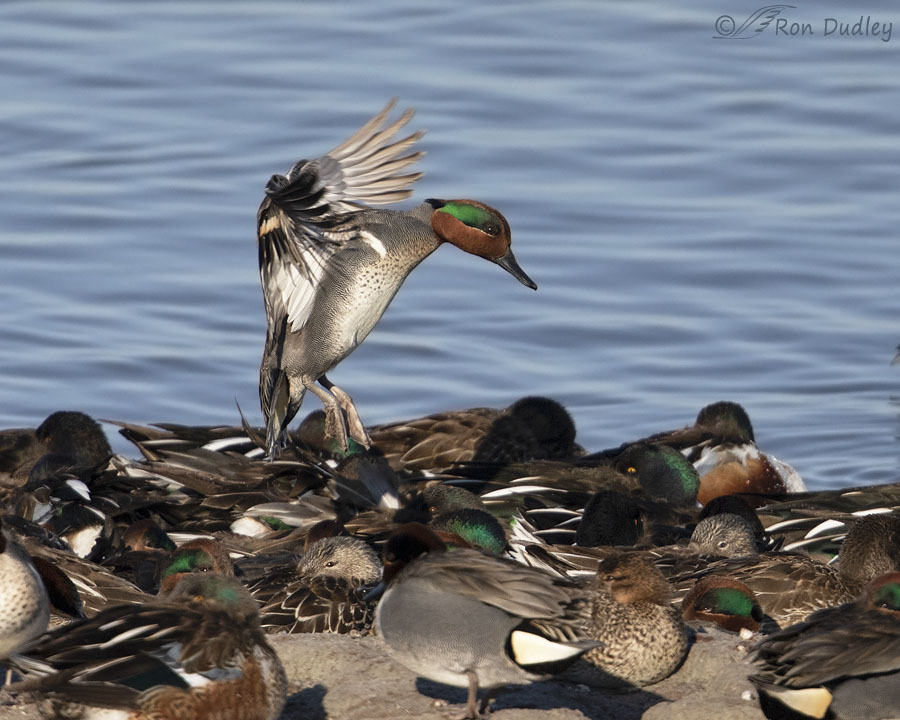Landing amongst the masses isn’t easy.

1/3200, f/6.3, ISO 500, Canon 7D Mark II, Canon EF 500mm f/4L IS II USM + EF 1.4 III Extender, not baited, set up or called in
Four days ago, in-between opportunities to photograph coyotes along the Antelope Island Causeway, I entertained myself by trying to photograph ducks in flight.
Somehow I managed to keep my focus point locked on this male Green-winged Teal as he swooped down to land amongst the masses of ducks basking in the sun along the shore. The ducks were so thick he had a hard time finding an open spot to land, which slowed him down enough to make it a little easier for me to keep my active focus point locked on him. With flying ducks I need all the help I can get and Green-winged Teals are our smallest dabbling duck so they’re an unusually difficult target to track in flight.
Northern Shovelers are the most common species along the causeway but there are also good numbers of Green-winged Teals and this guy decided to land amongst a group of ducks that were mostly of his kind. I was pretty happy to get him as sharp as I did with the other ducks and even the water in the background so close to him.

A tighter crop of the same photo makes him larger in the frame and allows the viewer to better appreciate what a challenge it was for him to find an open spot to land. He didn’t have much time to make a decision, especially at the speed of a landing duck.
It was tightly packed groups of ducks like this that the coyotes would rush in an attempt to snag one. In the resulting chaos and confusion it was often pretty easy for them to snatch one right out of the air.
The ducks are mostly gone now, at least they were by midmorning two days ago which was the last time I was there. Our warming temperatures have melted much of the ice around the lake so I suspect they’re dispersing to the increasing amount of open water available to them.
It was a blast while it lasted.
Ron


Mr Dudley, for a few months now I have been enjoying your bird photos and accompanying stories. I hope that one day my own bird photos will at least be closer to the high standard you have set.
I noticed that given shutter and aperture setting of your shots they very often are taken in very strong light. Could the altitude (and clear skies) be a factor?
I live in Ontario, Canada and we rarely have as much light even on sunny days.
Best regards
Hi, Jerzy. Please call me Ron. I left Mr. Dudley behind when I retired from teaching.
We often have clear days with strong light and that certainly can contribute to my usually high shutter speeds. However, I’m nearly always shooting in early morning when the light isn’t nearly as bright as one might think. My lens makes the biggest difference in that regard. It’s a very high quality 500 f/4 so it gathers a lot of light – what folks call a “fast lens”, especially at that focal length.
And I typically try to shoot at faster shutter speeds than most bird photographers, for several reasons – some of which may be fairly unique to me (shaky hands from essential tremors for example).
Hi Ron, New fan here. I kayak on Upper Newport Bay in southern California. It is one of the few remaining estuaries in our area and a major stopover on the Pacific Flyway. We seem to have a lot fewer ducks around this winter. Are you seeing more than usual?
I am not familiar with your neck of the woods. You say it is very cold, but why then, do you have open water?
Lastly, I am fascinated by your coyote stories. Maybe you already know this, but duck heads are apparently prized by domestic dogs as well: https://www.rawfeedingmiami.com/products/duck-heads
Welcome, Robin.
The majority of the Great Salt Lake is, well… salty. Very salty, so it typically doesn’t freeze. The water around the island is brackish, but still saline enough that it’s freezing point is significantly lowered. And even in our bodies of fresh water, when the water is running it doesn’t freeze nearly as easily as standing water.
So even in our coldest winters we usually have some open water and that’s where waterfowl congregate.
And yes, for much of this winter I saw fewer ducks than usual.
Some interesting items in your link, including “beef eyeballs”. $6.99/lb. for eyeballs isn’t a bad price. I think I used to pay at least that much for them 45 years ago when I first started buying them for dissection in my biology and zoology classes. But then ‘my’ eyeballs were in preservative, an added expense.
Incoming! Everybody Duck!
Yup, everybody’s a duck – no question about that.
Fun play on words, Lyle. Thanks for the giggle.
Really pretty birds. And good eating in a duck gumbo. 😀 My brother-in-law and niece are duck hunters. I love going home for their gumbo.
Arwen, to this day I’ve never eaten duck.
Beautiful! The green eye stripe has always made me think of a showgirl’s eye makeup getting just a little out of control — but it looks great on him, especially against that lovely brown face. Considering there’s plenty of room on the outer edge of the duck pile for him to land, perhaps he spotted his girlfriend in that crowd and wanted to be close to her! 😉
Hmmm, snuggling time, maybe. Thanks, Chris.
Smiling here. It reminded me strongly of pigeons coming in to land on our feeder – except that they make no attempt (that I can see) at finding a clear spot but just land on other birds.
Great shot.
I like your comparison to pigeons, EC. Thanks.
Nice! Beautiful green-winged teal captured at a great moment. 🙂 Those ARE tight quarters……… Wonder if the strategy is to get in the middle and, hopefully, be safer or keep warmer? Sure would make the coyotes job easier.
“Wonder if the strategy is to get in the middle and, hopefully, be safer or keep warmer?”
I’d presume so, Judy – especially the “warmer” part. If I recall it was in the low 20’s that morning. That sun must have felt good.
What an awesome photo! Green wings are such fun ducks to watch. I prefer to call them mini rockets because they seem to buzz so quickly, even if they aren’t the fastest duck species.
Do you ever see blue wing teal in the summer?
Shane, knowing how you love ducks I wondered if you’d see this.
I don’t recall seeing a blue-winged in summer. Pretty sure I haven’t photographed one.
Great job of keeping him sharp among all those others. Can’t imagine him actually finding a spot there and doesn’t look like anyone moves for you as you hover above. Did not know they are the smallest dabbling duck. Thanks for that. Always considered them to be among our handsomest ducks.
“Always considered them to be among our handsomest ducks.”
I heartily agree, Everett – especially the males with that iridescent green stripe behind the eye.